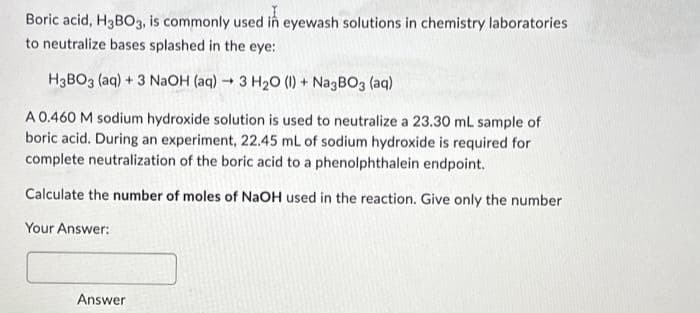Boric acid, H3BO3, is commonly used in eyewash solutions in chemistry laboratories to neutralize bases splashed in the eye: H3BO3 (aq) + 3 NaOH (aq) + 3 H₂O (1) + Na3BO3(aq) - A 0.460 M sodium hydroxide solution is used to neutralize a 23.30 mL sample of boric acid. During an experiment, 22.45 mL of sodium hydroxide is required for complete neutralization of the boric acid to a phenolphthalein endpoint. Calculate the number of moles of NaOH used in the reaction. Give only the number Your Answer: ARSUUR
Boric acid, H3BO3, is commonly used in eyewash solutions in chemistry laboratories to neutralize bases splashed in the eye: H3BO3 (aq) + 3 NaOH (aq) + 3 H₂O (1) + Na3BO3(aq) - A 0.460 M sodium hydroxide solution is used to neutralize a 23.30 mL sample of boric acid. During an experiment, 22.45 mL of sodium hydroxide is required for complete neutralization of the boric acid to a phenolphthalein endpoint. Calculate the number of moles of NaOH used in the reaction. Give only the number Your Answer: ARSUUR
Chemistry & Chemical Reactivity
9th Edition
ISBN:9781133949640
Author:John C. Kotz, Paul M. Treichel, John Townsend, David Treichel
Publisher:John C. Kotz, Paul M. Treichel, John Townsend, David Treichel
Chapter4: Stoichiometry: Quantitative Information About Chemical Reactions
Section: Chapter Questions
Problem 135SCQ: Two beakers sit on a balance; the total mass is 167.170 g. One beaker contains a solution of KI; the...
Related questions
Question

Transcribed Image Text:I
Boric acid, H3BO3, is commonly used in eyewash solutions in chemistry laboratories
to neutralize bases splashed in the eye:
H3BO3 (aq) + 3 NaOH (aq) → 3 H₂O (1) + Na3BO3(aq)
-
A 0.460 M sodium hydroxide solution is used to neutralize a 23.30 mL sample of
boric acid. During an experiment, 22.45 mL of sodium hydroxide is required for
complete neutralization of the boric acid to a phenolphthalein endpoint.
Calculate the number of moles of NaOH used in the reaction. Give only the number
Your Answer:
Answer
Expert Solution
This question has been solved!
Explore an expertly crafted, step-by-step solution for a thorough understanding of key concepts.
Step by step
Solved in 3 steps with 2 images

Knowledge Booster
Learn more about
Need a deep-dive on the concept behind this application? Look no further. Learn more about this topic, chemistry and related others by exploring similar questions and additional content below.Recommended textbooks for you

Chemistry & Chemical Reactivity
Chemistry
ISBN:
9781133949640
Author:
John C. Kotz, Paul M. Treichel, John Townsend, David Treichel
Publisher:
Cengage Learning

Chemistry & Chemical Reactivity
Chemistry
ISBN:
9781337399074
Author:
John C. Kotz, Paul M. Treichel, John Townsend, David Treichel
Publisher:
Cengage Learning

Chemistry: The Molecular Science
Chemistry
ISBN:
9781285199047
Author:
John W. Moore, Conrad L. Stanitski
Publisher:
Cengage Learning

Chemistry & Chemical Reactivity
Chemistry
ISBN:
9781133949640
Author:
John C. Kotz, Paul M. Treichel, John Townsend, David Treichel
Publisher:
Cengage Learning

Chemistry & Chemical Reactivity
Chemistry
ISBN:
9781337399074
Author:
John C. Kotz, Paul M. Treichel, John Townsend, David Treichel
Publisher:
Cengage Learning

Chemistry: The Molecular Science
Chemistry
ISBN:
9781285199047
Author:
John W. Moore, Conrad L. Stanitski
Publisher:
Cengage Learning

Chemistry: Principles and Practice
Chemistry
ISBN:
9780534420123
Author:
Daniel L. Reger, Scott R. Goode, David W. Ball, Edward Mercer
Publisher:
Cengage Learning

General Chemistry - Standalone book (MindTap Cour…
Chemistry
ISBN:
9781305580343
Author:
Steven D. Gammon, Ebbing, Darrell Ebbing, Steven D., Darrell; Gammon, Darrell Ebbing; Steven D. Gammon, Darrell D.; Gammon, Ebbing; Steven D. Gammon; Darrell
Publisher:
Cengage Learning

Introductory Chemistry: A Foundation
Chemistry
ISBN:
9781337399425
Author:
Steven S. Zumdahl, Donald J. DeCoste
Publisher:
Cengage Learning